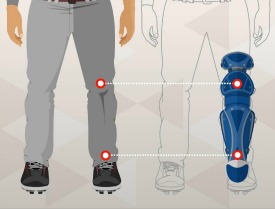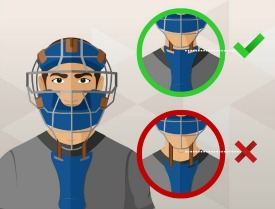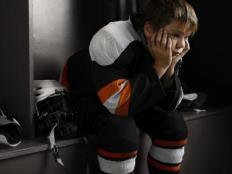How to Measure for a Catcher's Mask and Helmet
Once you've decided on which type of catcher's mask you want, you need to determine the proper size. Generally, masks come in adult and youth sizes, and for the most part, they follow hat sizes. To be sure you have the correct size for your catcher's mask, you can simply use a cloth measuring tape to determine your head's circumference.
Catcher's Chest Protectors
One of the most intense aspects of being a catcher is the potential for an injury to the chest region. There are many vital areas chest protectors can shield, including the collarbones and ribs, and they may even prevent possible cardiac injuries. Without a quality chest protector, you risk severe, possibly even fatal injuries. This piece of equipment needs to fit properly to prevent injury during a play.
There is a difference between a chest protector for softball players and baseball players. Softball player chest protectors have a break in the chest to help fit the shape of female players. Chest protectors for women also don't come with removable groin protectors. Even for men, the groin protector is not a required piece of the chest protector, but we will touch more on that later.
Features of Chest Protectors
There are many features of a chest protector, and all play a role in helping to protect the player using them.
Wings or Shoulder Pads
The wings or shoulder pads that are attached to a chest protector are meant to help protect the shoulder of the catcher. Without this added protection, a foul tip can strike your shoulder and cause serious damage to the muscle and/or bones. This feature really only became popular in the past decade because at one time players were worried the pads would restrict their throwing motion. Now with more technology behind the construction, you don't need to worry about having your motion restricted. These wings are usually lightweight and will move with you when you're throwing.
The wings or shoulder pads are usually detachable from the main chest protector, using either Velcro straps or snaps, and can be adjusted to provide the utmost amount of protection. Some catchers still prefer to not wear the shoulder pads on their throwing shoulder, but this is an individual personal player preference.
Groin Protectors
For youth leagues, wearing a groin protector is a requirement. As players get older, they are encouraged to wear a cup. The switch is simple since groin protectors are easy to remove. They are held onto the chest protector with Velcro straps or snaps, and can be added or removed in seconds. While it's not a requirement for high school and collegiate players, some players prefer to have double the protection and use both the groin protector and a cup.
Until you play the position of catcher full time, you won't know whether you prefer to use the groin protector or not. Some players remove them because they feel they inhibit their movement when stepping to throw. If you do decide to remove the groin protector, you should keep the Velcro area clean from dirt and debris to ensure it will continue to work should you ever want to attach it again.
What Size Chest Protector Should I Get?

As we touched on earlier, you want to make sure your chest protector fits properly at all times. To ensure you get the right size, measure yourself from the top of your sternum (just above your chest plate) to your waist, and this will give you the length for the best fit.
Chest protectors are measured by their length, so you need to accurately measure yourself. As long as you have the correct length, you should be able to adjust the tightness of the straps on the back. If necessary, you can tie off the straps to the appropriate snug fit. When purchasing for youth players, remember not to purchase anything larger than the player's current size. Do not buy a larger chest protector in hopes your player will grow into it, as this will not ensure the best protection and can be dangerous.
Catcher's Shin Guards

Shin guards are important as they help protect from scrapes on your knees and shins when going for foul balls and pitches in the dirt.
What Size Catchers Shin Guards Should I Get?
To get the proper measurement for your shin guards, you will need to measure from the middle of your knee to your anklebone. Look for a shin guard that's within a ½ inch of the measurement. Guards vary in size depending on the manufacturer. Sizes of shin guards usually fall within three categories: youth, intermediate, and adult, which fall in the 9-12, 12-15, and 16+ age ranges respectively.
When you try on your shin guards before purchase, you should have your uniform on to ensure you get the best fit. You also want to make sure the ankle plates are resting on the top of the tongue of your cleats. They should be snug on your legs, but not too tight. You'll want to make quick movements when trying them on to ensure the guards don't slip and that they stay comfortably in place.
Other Catcher's Gear

For ultimate safety, there is other protective gear you can consider including throat protectors and knee savers.
Throat Protectors
Many little leagues require this piece of gear that should hang off the lowest bar of the catcher's mask. It shouldn't be too tight, and when the catcher looks up, the throat protector should dangle down and protect the neck area.
Knee Savers
Many people consider knee savers to be the catcher's best friend. They relieve the pressure and stress off your knees. There's some discussion as to whether young players need knee savers. The controversy lies in a debate over whether they're an important tool to help save young players' knees, or if they could potentially hinder the growth of the leg muscles, and in turn, the endurance of the player.  Some even argue that they make a player lazy, but for those players coming off knee injuries, most agree knee savers are definitely valuable.
Some even argue that they make a player lazy, but for those players coming off knee injuries, most agree knee savers are definitely valuable.
Catcher's Mitts
Catchers can't use a regular fielding glove. There are mitts made specifically for the position that help protect your hand and make things like scooping a pitch in the dirt easier to do. For more information on catcher's mitts, check out our Glove Buying Guide.
When you first start shopping around for catcher's gear, one of the first things you'll likely notice is that the lighter pieces can be more expensive. Keep in mind that the difference in cost will often be a result of the material used, which is designed to be very durable, while still allowing a catcher to be as agile as possible. The difference between the lighter and heavier equipment doesn't always correlate to quality — just because the lighter gear is more expensive doesn't mean that the heavier gear won't protect you as much. It's really a matter of comfort, personal preference, convenience, and how much you want to spend.
 Find baseball camps and clinics near you.
Find baseball camps and clinics near you.
- 2
- of
- 2
About the Author

Baseball Monkey is a leading retailer of baseball and softball equipment for all ages and experience levels. Our expert team worked together to build a resource hub of information designed to help players navigate through the many questions that come with gearing up for the baseball season.
MonkeySports, Inc. has been serving athletes around the world since 1999. We offer expert customer service and product knowledge that comes from employing players who are passionate about the game, the gear and the customer. MonkeySports, Inc. has six established brick-and-mortar stores and six websites. Our online stores operate under the banners hockeymonkey.com, goaliemonkey.com, lacrossemonkey.com, baseballmonkey.com, monkeyteamsports.com and monkeyapparel.com.









Discuss This Article